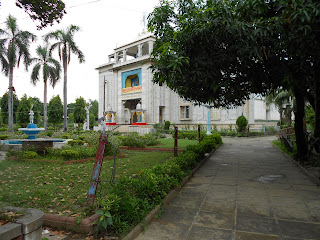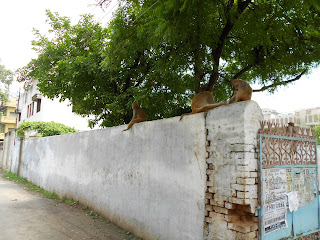Yesterday, I went on an adventure around town, visiting several places (some including pictures).
First, I went on a walk around town, meaning I just walked in every direction (of course, maintaining some sort of idea as to where I actually was), stumbling on a couple of temples (not surprisingly, since temples here are like churches in the American South), a pack of monkeys, and some apartment complexes. This first picture is of a local post office building. I’m not sure what it used to be.
Some monkeys. They were just chilling.
Then, I headed toward Assi Ghat, the ghat closest to our guest-house. There, I unsuspectingly met up with one of my fellow interns, and we visited a famous ashram here, dedicated to a woman saint. It was super-interesting, but I felt somewhat out-of-place without knowing her background and all the proper procedures for taking a tour of an ashram. It was definitely cool and very pretty though! The amount of stone in all of these temples is simply incredible, and I really like the moderately bare aesthetic in the body of the temple (generally the altars are pretty packed though). After that, I took a walk back to the guesthouse, and took some pictures of transportation (I’ll post those soon).
After lunch, I went to BHU. Here is the statue at BHU's main gate, of the founder of the university.
I went to the ayurvedic garden, which was essentially a wilderness/botanical garden. It was really interesting to compare that with the well-kept botanical gardens in the States.
Here's a pretty flower in the botanical garden! Note the wilderness going on in the background.
I also went to the Madurayadas (possibly misspelled here). It was a moderately well-kept sculpture garden. It was a nice place to sit (despite the fact that there were several people staring at me, including a couple who came to sit closer to me and stare for a closer look). The sculptures were also interesting- the collection there made it seem like Indians have a particular affinity for cubism and modern sculpture. This is the view from where I decided to sit and read my book.
The weather started turning gloomy (finally some rain!) and this resulted in a tree falling over in the middle of the road by the garden (saw it happen-super crazy!) and a motorbike accident in the middle of the road (didn’t see it happen, but the response was just normal people cleaning up- generally ambulances are really slow here, as are police responses). I then stopped and got an ice cream cone, and walked home in the rain. It probably looked pretty strange to everyone, but to me it seemed just fine.








































